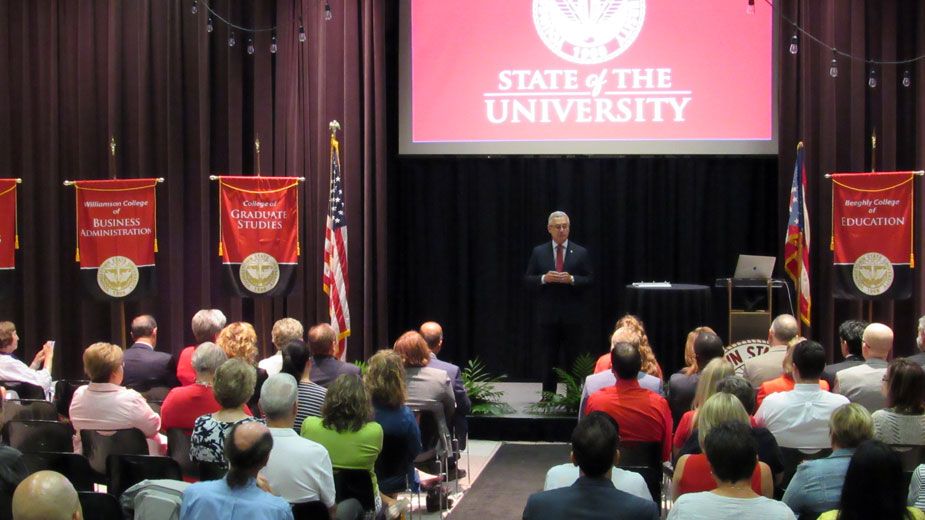Tressel Touts University Accomplishments, Impact
YOUNGSTOWN, Ohio — The future of Youngstown State University and its impact is often guided by the singular act of listening and becoming engaged with the community, according to YSU President Jim Tressel.
“All of the things that we’re doing are based upon the needs that we hear people talk about,” Tressel said shortly after delivering the State of the University address Aug. 20. “It’s based on what the region is asking for.”
These initiatives range from investments such as a new student recreational field just off Elm Street, to the construction of what many consider to be a model facility for an advanced manufacturing and commercialization center that could spur sustained, long-term economic development.
Along with a student recreation field, the campus is looking to add an indoor tennis and bowling center just west of the softball fields, Tressel announced. Additional parking lots would be developed – one where the current outdoor courts are across from Kilcawley Center and another farther west of the M-26 lot – in order to keep the same number of available spaces for students, faculty and staff.
“To me, the exciting challenge is how do you anticipate what the needs of society are going to be, what the needs of the region are going to be,” he said.
More students are living on or around campus than ever before – approximately 2,500 walk to the university today, the president said. “We have to make sure that we can provide the experience for them – the amenities, the opportunities to work on campus. It’s a little bit of a changing dynamic.”
Other improvements slated for the university neighborhood are rehabilitating Fifth Avenue from a six-lane thoroughfare and converting it into a two-lane road with a middle turning lane, Tressel said, citing safety issues. “We have more people walking around campus,” he said. “It’s tough to walk across six lanes.”
Tressel noted that over the last four years, a special emphasis has been placed on student success, which he said not only embraces enrollment, but also student retention. “This fall, we have the largest incoming class since 2010,” he said, with an average GPA of 3.35, the highest ever for an incoming freshmen class.
He also announced during the address that the university has earned reaccreditation through 2027 from the Higher Learning Commission. “We had high marks,” with YSU in compliance in 20 out of the 21 segments. Just one aspect – academic programs – rated the university was in compliance but with concerns.
The reaccreditation came at just the right time, Tressel said, noting that the university is in the process of developing a new strategic plan. It is asking community leaders and stakeholders at YSU to provide insight and input to the process, and has positioned research materials on the university’s website so faculty, students and staff can familiarize themselves with the information that is out there.
Another goal the university has targeted is to hit the $100 million mark for the “We See Tomorrow” capital campaign by December 2019, Tressel said. Thus far, the university has raised about $75 million and would like to add another $15 million this year
But perhaps one of the strongest assets of YSU is the overall impact the university has on the entire region, Tressel said.
About a year ago, Tressel was invited to deliver a presentation before the Ohio Department of Higher Education to help identify the needs and challenges confronting state-funded colleges and universities.
In the past, these discussions focused on subjects such as the burden of student debt, whether a four-year college degree is really that important, or whether there should be free tuition in the state.
Yet Tressel noticed that the one element missing from the conversation was the overall impact the university system has on their respective regions – especially YSU and the five-county area in northeastern Ohio and western Pennsylvania that it mostly serves.
“I really felt that one of the things that was missing in the discussion of the importance of higher education was our impact,” Tressel told an audience of about 400. He elicited the advice of two YSU faculty members, A.J. Sumell a professor of economics, and Sepideh Khavari from mathematics and statistics to help craft a presentation that would demonstrate just how important these centers of education are to the entire state.
The presentation led to the state examining more closely the economic, social and academic impact of colleges and universities in their regions. A third-party firm from Oregon – Economic Modeling Specialists International – was contracted to perform the analysis, and the results were made available in June.
“We have $923.9 million of impact in this five-county area every single year – pretty extraordinary,” Tressel said. “For every one dollar a student invests in a YSU education, they get back a cumulative $5.20 in increased lifetime earnings.”
Moreover, the study showed that YSU – students, faculty and graduates – supported 15,688 jobs in Mahoning, Trumbull and Columbiana counties in Ohio, and Lawrence and Mercer counties in western Pennsylvania.
Tressel noted that annually, faculty boasts collaborations with eight foreign countries, 12 industry partners, 21 universities and another 75 partners.
Much of this has come as a result of YSU successfully establishing partnerships with the private sector, schools such as Eastern Gateway Community College and area technical centers, and organizations such as the Youngstown Business Incubator and America Makes. “We’re a global leader in additive manufacturing,” he said. “We’ve demonstrated more so than anyone in this state, that if you collaborate with your partners, you can become the best in the world.”
Such is the impetus behind the Mahoning Valley Innovation and Commercialization Center, a project to develop a shared learning and ideation laboratory related to advanced manufacturing. The university earlier this year purchased the former Mahoning County misdemeanant jail and plans to convert it into the new facility.
Newly appointed YSU Trustee Charles George said that he is impressed with what Tressel has accomplished over the last four years, and believes the university is on the right track.
“He’s really on point with projects such as the MVICC,” George said. “This could be a model for the state and possibly the country.”
George says the opportunity to develop more public/private partnerships can only help the university in the near term. “I’m excited about it to say the least,” he said.
Tressel also emphasized professions such as education, where more than 600 student teachers have an economic impact of $4 million a year to the region. Another 2,500 patients received free appointments last year through the dental hygiene program.
“We’re going to continue to keep moving forward in the areas of enrollment, retention and research dollars that we’ve been able to attract,” he said.
Copyright 2024 The Business Journal, Youngstown, Ohio.



